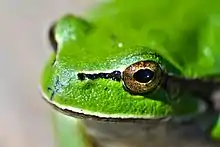anuran
English
WOTD – 9 May 2017
Etymology
From New Latin Anoura, Anura (“name of the order of amphibians”), or from French Anoures (“name of a family of amphibians”) (from Latin an-, from Ancient Greek ἀν- (an-), from Proto-Indo-European *n̥- (“prefix meaning ‘not’”) + Ancient Greek οὐρά (ourá, “tail”), ultimately from Proto-Indo-European *h₃érsos (“backside, buttocks”)) + -n (from Latin -ānus (“suffix meaning ‘of or pertaining to’”), from -nus, from Proto-Indo-European *-nós (“suffix creating adjective nouns from verbs”)).
Pronunciation
- (Received Pronunciation) IPA(key): /əˈnjʊəɹ(ə)n/
- (General American) IPA(key): /əˈn(j)ʊɹən/, /æ-/
- Hyphenation: an‧ur‧an
Noun
anuran (plural anurans)
- (batrachology) Any amphibian of the order Anura; a frog, a toad.
- 1871, William Kitchen Parker, “VIII. On the Structure and Development of the Skull of the Common Frog (Rana temporaria, L.). By William Kitchen Parker, F.R.S. Received October 10, 1870,—Read January 19, 1871.”, in Philosophical Transactions of the Royal Society of London, volume 161, part I, London: Printed by Taylor and Francis, Red Lion Court, Fleet Street, OCLC 715761850, page 202:
- The fact that the higher Batrachia go on metamorphosing until several of their structures are so perfect as to require but the gentlest modification to make them fit for the Mammal, does not require one to suppose that the Toad and the Frog lie in the direct route from the Ichthyic to the Mammalian types. That such power of variation, such aptitude for transformation exists in these essential but metamorphic Fish, suggests the probability that some of the very earliest of the Amphibia, filial perhaps to forms far lower than the Lamprey, did not stop at the last metamorphic stage of an Anuran, but changed still further, and thus laid the foundation of the higher classes.
- 2001, George R. Zug; Laurie J. Vitt; Janalee P. Caldwell, “Thermoregulation, Performance, and Energetics”, in Herpetology: An Introductory Biology of Amphibians and Reptiles, 2nd edition, San Diego, Calif.; London: Academic Press, →ISBN, page 191, column 1:
- Inactivity may dominate an anuran’s life. Spea hammondii in the deserts of southwestern North America spend >90% of their life inactive; they appear explosively and breed with the first heavy summer rains, then feed for 2–3 weeks before becoming inactive for another year.
- 2006, Kevin M. Wright, “Overview of Amphibian Medicine”, in Douglas R. Mader, editor, Reptile Medicine and Surgery, 2nd edition, St. Louis, Mo.: Saunders Elsevier, →ISBN, page 947:
- Often the anuran gives a release call, a signal to other anurans that it is either not sexually receptive or is of the wrong sex to be amplexed. The release call may sound similar to a distress call, a vocalization emitted by an anuran in response to predation, but either call may serve to startle a clinician momentarily, by which time the anuran may escape.
-
Related terms
Translations
Adjective
anuran (not comparable)
- (batrachology) Of or relating to the order Anura.
- 1934, Julian S[orell] Huxley; G[avin] R[ylands] de Beer, “Organisers: Inducers of Differentiation”, in The Elements of Experimental Embryology, Cambridge: At the University Press, OCLC 912072999, page 142:
- As a further illustration, we may take the results of experiments in which a Urodele organiser (from Triton alpestris) is grafted into an Anuran embryo (Bufo vulgaris).
- 1971, J. R. Tata, “Protein Synthesis during Amphibian Metamorphosis”, in A[ron] A[rthur] Moscona and Alberto Monroy, editors, Current Topics in Developmental Biology, volume 6, New York, N.Y.; London: Academic Press, →ISBN, page 79:
- It is well known that an anuran tadpole or an insect larva will never turn into its adult form if the respective endogenous metamorphic hormones, thyroxine and ecdysone, were withdrawn or prevented from reaching the target tissues.
- 1989, Eric H[arris] Davidson, “An Analysis of Niu Mengchang’s Research on Transformation by RNA”, in Dean H. Hamer and Shain-dow Kung, editors, Biotechnology in China, Washington, D.C.: National Academy Press, →ISBN, page 94:
- [I]njection of urodele DNA into an anuran (frog) egg produces an extra "balancer" (i.e., protrusion on the chin of the embryo which may or may not be a real balancer), but so does injection of the DNA of this anuran into its own egg.
-
Synonyms
Hypernyms
Further reading

This article is issued from Wiktionary. The text is licensed under Creative Commons - Attribution - Sharealike. Additional terms may apply for the media files.
